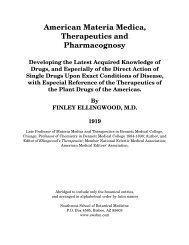SCARLET FEVER. Synonyms.—Scarlatina; Scarlet Rash. Definition ...
SCARLET FEVER. Synonyms.—Scarlatina; Scarlet Rash. Definition ...
SCARLET FEVER. Synonyms.—Scarlatina; Scarlet Rash. Definition ...
You also want an ePaper? Increase the reach of your titles
YUMPU automatically turns print PDFs into web optimized ePapers that Google loves.
force of the poison, we' find warty excrescences, producing endocarditis.<br />
Deposits may also take place on the valves.<br />
The respiratory tract is also invaded by this foe of the human race, the<br />
nose in rare cases showing the characteristic deposit. The larynx, as well<br />
as the trachea and bronchi, are occasionally involved. The lungs prove<br />
no exception to the general rule, the deposits usually selecting the<br />
middle and lower lobes rather than the apices, as in tuberculosis.<br />
Testicles.—The gummatous deposits frequently select the testes as a<br />
fruitful soil for a display of their action, forming indurated masses in the<br />
body of the organ. The gland is swollen and enlarged, though but little<br />
painful. There is but little tendency to degeneration. The location of the<br />
deposit enables one to recognize it from tuberculosis, which seeks the<br />
epididymis as a nesting-place.<br />
Congenital Syphilis.—The same conditions, expressed by similar<br />
symptoms, are to be found in congenital as well as in acquired syphilis,<br />
with the exception of the initial lesion, the chancre. The disease may<br />
show its characteristics while yet in utero, at birth, a few weeks later, or<br />
at puberty. The lesion will be considered in this order.<br />
In Utero.—That the fetus feels the force of the virus while yet in utero,<br />
and shares in its destructive powder, is seen in frequent abortions and<br />
the presence at birth, or a few days later, of bullæ on the hands and<br />
feet, pemphigus neonatorum.<br />
There are changes that take place in the viscera, and, though rare, are<br />
corroborated by such men as Gubler, Rochenbrome, Barensprung, and<br />
others. Hutchinson says: “Of these, a parenchymatous infiltration—<br />
fibroplastic—of the liver, for the most part without large gummata, is<br />
the most common. It is sometimes attended by anasarca, and similar<br />
lesions occur in the lung. If not actually present at birth, it may develop<br />
soon afterwards, and may then lead to jaundice and death.<br />
Infiltrations of the same kind may be found also in the spleen, tlie<br />
kidneys, the thymus gland, and even in the heart. Occasionally larger<br />
and more circumscribed deposits are found, and sometimes softening<br />
occurs and abscesses form. These pathological processes occur chiefly<br />
during the later period of intra-uterine life, and are no doubt<br />
responsible for the majority of cases being born dead at, or near, full<br />
time. They may also occur during the first few weeks of life. At this age<br />
The Eclectic Practice of Medicine - PART I - Infectious Diseases - Page 222

















